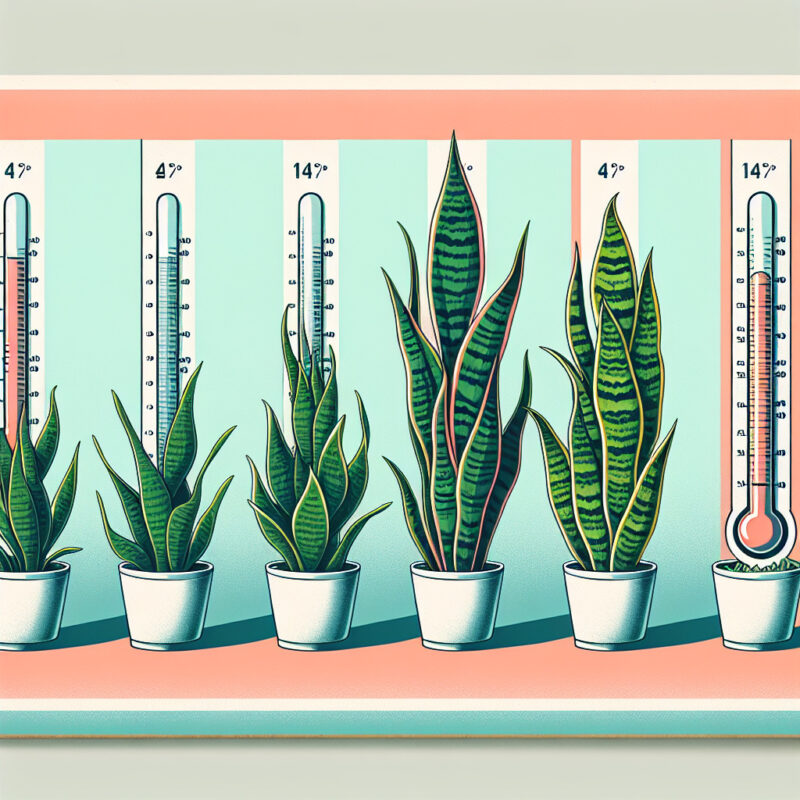Snake plants, scientifically known as Sansevieria, are widely recognized for their striking appearance and low-maintenance nature. While their resilience is well-known, understanding what temperature conditions they can tolerate is crucial for their thriving growth. These remarkable plants, native to arid regions of West Africa, have adapted to withstand fluctuating temperature ranges, making them resilient additions to any indoor or outdoor space. In this article, we will delve into the various temperature aspects of snake plants, shedding light on the extremes these hardy plants can endure and the optimal conditions for their overall well-being. Whether you are a seasoned gardener or a plant enthusiast, knowledge of what temperature can snake plants tolerate is essential for cultivating healthy and flourishing specimens.
key Takeaways
What Temperature Can Snake Plants Tolerate?
Snake plants, scientifically known as Sansevieria, are popular indoor houseplants due to their adaptability and low maintenance requirements. These plants are native to West Africa and are characterized by their upright, sword-shaped leaves. One of the key factors to consider when caring for snake plants is understanding their temperature requirements.
Optimal Temperature Range
Snake plants are known for their ability to tolerate a wide range of temperatures, making them suitable for various indoor environments. The optimal temperature range for snake plants is between 70°F (21°C) and 90°F (32°C). Within this range, snake plants thrive and display optimal growth.
Minimum Temperature
Snake plants can tolerate lower temperatures, but it is essential to note that they are sensitive to cold drafts and sudden temperature drops. The minimum temperature that snake plants can tolerate without significant damage is around 50°F (10°C). Exposure to prolonged lower temperatures may lead to leaf discoloration and even plant death.
Maximum Temperature
While snake plants can tolerate high temperatures, extreme heat can negatively impact their overall health and growth. The maximum temperature that snake plants can tolerate without adverse effects is around 90°F (32°C). Beyond this temperature, the plant may experience wilting, leaf curling, and even permanent damage.
Temperature Fluctuations
Although snake plants can adapt to different temperature ranges, they are sensitive to rapid and drastic fluctuations. Avoid placing snake plants near heating or cooling vents, as sudden temperature changes can stress the plant and lead to leaf damage. It is best to maintain a consistent temperature within the optimal range to ensure the plant’s well-being.
Protective Measures
Providing adequate protection during extreme temperatures is crucial for maintaining the health of snake plants. During colder months, consider moving the plant away from drafty windows and doors. In hot climates, provide shade or move the plant to a cooler spot to prevent overheating. Additionally, maintaining proper humidity levels can help mitigate the effects of extreme temperatures on snake plants.
Understanding the temperature tolerance of snake plants is vital for their overall well-being and longevity. By ensuring that the temperature remains within the recommended range and protecting the plant during extreme conditions, you can enjoy the beauty of this resilient indoor plant for years to come.
https://youtube.com/watch?v=MiqtF2YgJbs
FAQs about Snake Plant Temperature Tolerance
1. What is the ideal temperature range for snake plants?
Snake plants, scientifically known as Sansevieria, prefer temperatures between 70°F and 90°F (21°C – 32°C). These plants thrive in warm environments, but they can also tolerate temperatures as low as 50°F (10°C) for short periods.
2. Can snake plants survive in cold temperatures?
While snake plants can tolerate cooler temperatures, it’s important to avoid exposing them to freezing conditions. Prolonged exposure to temperatures below 50°F (10°C) can damage the plant and even lead to its death.
3. Do snake plants prefer warm or cool climates?
Snake plants are native to tropical Africa and thrive in warm climates. They do well in average room temperatures, making them suitable houseplants for most homes. However, they can adjust to slightly cooler conditions if necessary.
4. Can snake plants tolerate high temperatures?
Snake plants can withstand high temperatures up to a certain point. While they can tolerate temperatures up to 90°F (32°C), it’s important to ensure proper airflow and ventilation in hot environments. Excessive heat may cause the leaves to droop or develop brown, scorched tips.
5. Can snake plants survive in outdoor gardens with fluctuating temperatures?
Snake plants are versatile and can adapt to various environments, including outdoor gardens. However, they are more susceptible to temperature fluctuations than indoor plants. If you plan to grow snake plants outdoors, ensure that the temperatures in your region stay within the plant’s preferred range.
Exploring Different Types of Snake Plants
Sansevieria trifasciata ‘Black Gold’
This snake plant cultivar features thick, vertical leaves with dark green coloring and golden variegation. The ‘Black Gold’ variety can tolerate a wide range of temperatures, making it suitable for both indoor and outdoor growth.
Sansevieria cylindrica
Also known as the cylindrical snake plant, this species has long, stiff leaves that grow upright. It’s a popular choice for modern interiors due to its unique form. Snake plants of this type are well-suited to average room temperatures and can tolerate slightly cooler conditions.
Final Thoughts
Snake plants are sturdy houseplants that can tolerate a range of temperatures, making them suitable for various environments. They thrive in warm climates and prefer temperatures ranging from 70°F to 90°F (21°C – 32°C). While they can withstand cooler conditions for short periods, freezing temperatures should be avoided.
When growing snake plants outdoors, ensure that the temperatures in your region align with the plant’s preferred range. Additionally, it’s important to consider the specific types of snake plants you’re cultivating, as certain cultivars may have different temperature preferences. By providing the ideal temperature conditions, you can promote healthy growth and ensure the longevity of your snake plants.

